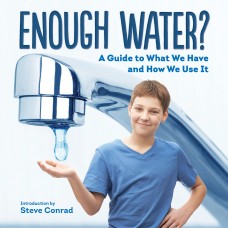| ________________
CM . . .
. Volume XXIII Number 13. . . .December 2, 2016

 |
Enough Water? A Guide to What We Have and How We Use It.
Steve Conrad.
Richmond Hill, ON: Firefly Books, 2016.
72 pp., trade pbk. & hc., $9.95 (pbk.), $24.95 (hc.).
ISBN 978-1-77085-818-3 (pbk.), ISBN 978-1-77085-819-0 (hc.).
Subject Headings:
Water consumption-Juvenile literature.
Water use-Juvenile literature.
Water conservation-Juvenile literature.
Sustainable living-Juvenile literature.
Grades 3-6 / Ages 8-11.
Review by Gail Hamilton.
***½ /4
|
| |
|

excerpt:
The images we see on the news can be confusing. On one hand we may witness instances where there is too much water, when places flood. On the other hand, we see farmers leaving their farms because there is not enough water to grow anything. Both flooding and water scarcity are two sides of the same coin, and they can be blamed mostly on human activities. Filling in wetlands, which act like sponges to soak up excess rainwater, to create more farmland or sites for development is one key example. Another example is greenhouse gases released into the atmosphere when oil and gas are burned for transportation, generating electricity and home heating. The increase in greenhouse gases results in changing weather patterns. This causes more rain, rising sea levels and a warmer atmosphere.
Using mostly infographics, this educational and eye-opening book raises awareness of the importance of water and the necessity of reducing our water consumption. Following an introduction, there are three main chapters, the first of which explains that only 2.5% of Earth’s water is drinkable (the same ratio as 3 teaspoons in an 18-litre/5 gallon container). Though most readers might be familiar with the term “carbon footprint”, in this chapter they will be introduced to the term “water footprint”, the amount of freshwater used to grow food and manufacture the goods that people use. Other topics include the sources of tap water, a comparison between residential water consumption of Americans and Canadians, and water usage in the home.
The longest, and most shocking, chapter is “Water By the Numbers”. Here, author Steve Conrad, Associate Director of the Pacific Water Research Centre at Simon Fraser University, shows readers just how much water is used for various activities, such as brushing one’s teeth or doing a single load of laundry, and how much water it takes to produce certain foods and articles of clothing or technological gadgets. For example, a 10-minute shower uses 160-190 liters of water, while a dishwasher uses 36 liters per load. To produce one pair of jeans requires 7, 600 liters of water (not counting laundering those jeans once they have been purchased), from growing the cotton to the manufacturing process to delivery to the retail store. The manufacture of one smartphone requires 910 liters “from creating the microchips to mining the metals used in the batteries to polishing the silica glass used in their touch screens”. To produce a single tomato, 50 liters of water are necessary, while a kilogram (35-ounce) bottle of ketchup requires 530 liters. Readers will realize that a meat-based diet consumes almost twice as much water as a vegetarian diet. This chapter’s strength lies in the infographic style of presentation. As the idiom states, “A picture is worth a thousand words” and in this case, readers will readily see the water footprint of many common objects and foods.
Water-saving tips are featured in the final chapter, but, while children will benefit from reading about them, the suggestions are mainly for adults. This information is divided into three sections: tips for indoors (bathroom, kitchen and laundry), outdoors, and lifestyle. The lifestyle section is mainly about supporting and promoting water conservation initiatives.
Illustrations consist of colour photographs, diagrams and a few maps. A table of contents, a glossary and an index are also included.
Highly effective in its approach and most engaging, Enough Water? is insightful and informative, and, hopefully, will lead to a greater awareness of water-consumption issues and changes in behavior with regard to water usage and conservation.
Highly Recommended.
Gail Hamilton, a former teacher-librarian, lives in Winnipeg, MB.

To comment
on this title or this review, send mail to cm@umanitoba.ca.
Copyright © the Manitoba Library Association. Reproduction for personal
use is permitted only if this copyright notice is maintained. Any
other reproduction is prohibited without permission.
Next Review | Table of Contents For This Issue - December 2, 2016
CM Home | Back Issues
| Search
| CM Archive
| Profiles Archive
|
